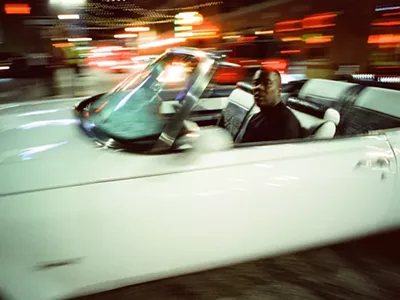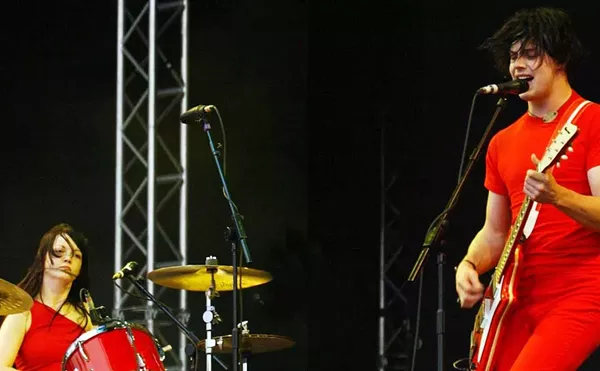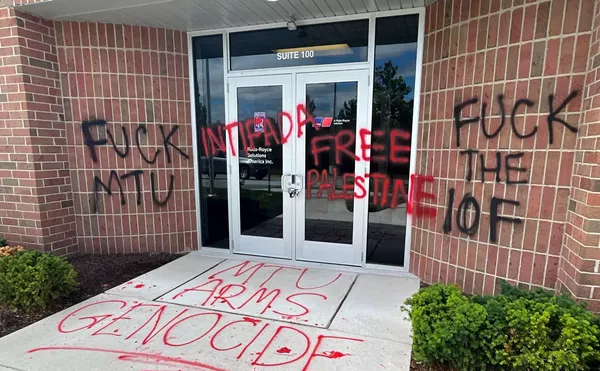

Audio By Carbonatix
[
{
"name": "GPT - Leaderboard - Inline - Content",
"component": "35519556",
"insertPoint": "5th",
"startingPoint": "3",
"requiredCountToDisplay": "3",
"maxInsertions": 100,
"adList": [
{
"adPreset": "LeaderboardInline"
}
]
}
]
Eddie Muller, the Los Angeles-based, self-proclaimed "Czar of Noir," has dedicated his life to not just keeping the legacy of Hollywood's film noir movement alive — those cinematic odes to hardboiled anti-heroes, enchanting femme fatales, and the gritty underbelly of society — but of preserving America's old-school movie palaces as well.
That's why linking up with Detroit's historic Redford Theatre was a no-brainer for the traveling festival, now in its fourth year. But when the opportunity presented itself to partner with the Detroit Institute of Arts' Detroit Film Theatre, Muller says he couldn't resist. This year's fest kicks off at the DFT on Friday before moving to Redford.
"I didn't want to leave [the Redford]," Muller says. "When I saw the theater at the DIA, I said, 'Wow, this is a great house. This would be really fun to do a show here.' Obviously, my hope is that I'll catch some new people on Friday night at the DIA and maybe be able to convince them to come to the weekend shows at the Redford."
For Muller, it's all about keeping the tradition of movie-going alive in the era of Netflix and chill. "I'm a preservationist of film, but I realize that you also have to preserve the venues, the classic venues, and preserve the movie-going experience," he says. "Like, it's better to watch these movies in a classic theater on a big screen than it is to watch them on your laptop."
It's also about building an audience.
"I appreciate all the old timers who come out and say, 'I saw this movie when it opened and blah, blah, blah,'" Muller says. "But quite honestly, I'm doing this for the younger people too, to show them that this is what it used to mean to go to the movies. And I really hope to attract young, curious people who might think, well, 'What is it about these old movies? Because aren't they kind of corny? And who would watch a black and white movie?'"
To that end, Muller has curated each year's Noir City festival with a loose theme to help give them extra context within not just Hollywood history, but American history.
"I think it really enhances the experience, and I'm hoping it makes them a fan for life," he says.
This year's theme is film noir in the 1950s. While the heyday of the movement is generally regarded as the 1940s, this year Muller wants to show how the movement changed as it moved into the next decade.
What changed is the rise of television as a medium. The dark and murky palettes of film noir didn't translate well to early television tubes, and there was also a push for movies to go widescreen in order to compete with the square format of TV sets.
"The difference between '47 and '57 is huge," Muller says.
That change is evident in a film like Niagara, the 1953 film starring Marilyn Monroe that screens at the Redford on Saturday. The film is notable because it stars Monroe the same year she made her debut as the centerfold in the inaugural issue of Playboy magazine, and also because it was shot in color. "That's the film that I always like to point out when people say if it's in color, it can't be film noir," Muller says. "What else would you call this movie? I mean, it's completely film noir. It just happens to be lush color."
But the raison d'être for Noir City is preservation of endangered movies, with money raised from the festival, along with grants, going toward film restoration projects. This year's festival will showcase two films that are the fruits of those labors.
The fest kicks off at the DFT with the 1952 film The Turning Point, which Paramount agreed to make a digital version of using the negative in its archives due to what Muller describes as his "incessant nudging." On Saturday, the fest will show the 1949 film Trapped alongside Niagara, restored from a print Muller helped track down. Thanks in part to Muller's efforts, that film is set to get its first-ever Blu-Ray release in 2020.
Muller says he is humbled by the festival's generous benefactors. "We have a few significant donors, but most of the money just comes from fans who donate $20, $50, a hundred bucks, 500 bucks, whatever they can spare," he says. "What's amazing is that people donate to us from all over the world, even if they're just hoping that they'll see the results of it someday."
Film noir may be famous for those morally compromised anti-heroes, but it seems that its 21st century fans are anything but.
Noir City opens on Friday, Sept. 20 at the Detroit Film Theatre; 5200 John R St., Detroit; 313-833-4005; dia.org; and continues Saturday, Sept. 21 and Sunday, Sept. 22 at the Redford Theatre; 17360 Lahser Rd, Detroit; 313-537-2560; redfordtheatre.com. Tickets are $10 for individual shows or $35 for weekend passes.
Get our top picks for the best events in Detroit every Thursday morning. Sign up for our events newsletter.






